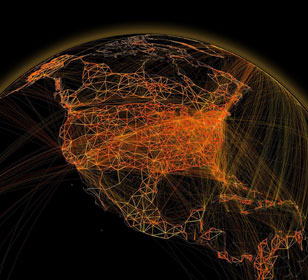 The interplay of human mobility patterns like those between local metropolitan commuters and long-range airline travelers during a global epidemic can be modeled in such detail so as to offer refined views of epidemics that could aid in public health emergency decision making, according to new research published by Professor Alessandro Vespignani's research team at Indiana University. The findings, published this week in the Proceedings of the National Academy of Sciences' Online Early Edition, also note that with these refined computational strategies, new levels of accuracy about the behavior of targeted mobility networks and epidemic progression can be imagined. Contributing with Vespignani on the paper were research scientists Duygu Balcan and Bruno Goncalves of the IU School of Informatics and Computing, and the Pervasive Technology Institute, IU Physics Department graduate student Hao Hu and research scientists Vittoria Colizza and Jose Ramasco of the Institute for Scientific Interchange Foundation in Torino, Italy. More…
The interplay of human mobility patterns like those between local metropolitan commuters and long-range airline travelers during a global epidemic can be modeled in such detail so as to offer refined views of epidemics that could aid in public health emergency decision making, according to new research published by Professor Alessandro Vespignani's research team at Indiana University. The findings, published this week in the Proceedings of the National Academy of Sciences' Online Early Edition, also note that with these refined computational strategies, new levels of accuracy about the behavior of targeted mobility networks and epidemic progression can be imagined. Contributing with Vespignani on the paper were research scientists Duygu Balcan and Bruno Goncalves of the IU School of Informatics and Computing, and the Pervasive Technology Institute, IU Physics Department graduate student Hao Hu and research scientists Vittoria Colizza and Jose Ramasco of the Institute for Scientific Interchange Foundation in Torino, Italy. More…